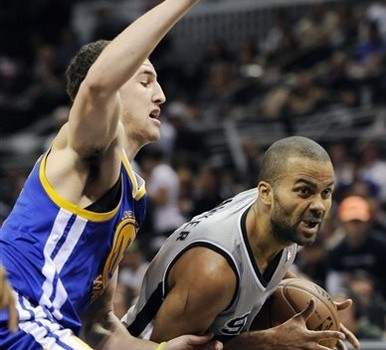Stephen Curry’s hot hand may be limited to the court, but over the last month he has set the basketball world on fire. After suffering through the Curry experience in Game 1, the Spurs began experimenting new defensive strategies to be used on Curry. Amid the cries of “top five point guard!” and “best shooter ever!” Gregg Popovich was focused on slowing the newly anointed star.
Though likely helped by an ankle injury, the Spurs have greatly limited Curry since Game 2. In three games since the Game 2 victory in San Antonio, Stephen Curry has a true shooting percentage of only 47.9 percent, far below of 58.9 percent true shooting during the regular season and 57.1 percent for the playoffs. These struggles have not simply been a matter of scoring efficiency. Curry’s assist percentage (percent of teammates field goals assisted while on court) has dropped from his regular season 31.1 percent to 24.1 percent, and his usage rate has dropped from 26.4 percent to 22.6 percent. Along with dramatically limiting his efficiency, the Spurs have pressured Curry out of his typical rate of creation.
In Game 1 Tony Parker was Stephen Curry’s primary defender. Since then, Curry has primarily faced Danny Green, with intermittent spurts versus Tony Parker and Kawhi Leonard. Tony Parker is a match-up liability versus the Warriors’ large wings, but the Spurs are clearly willing to surrender this in exchange for the ability to keep Green consistently matched up with Curry.
In his second year in San Antonio, Danny Green has developed into a very good perimeter defender. Warriors fans may recognize his ability to use his length to his advantage after recently admiring Klay Thompson’s defense. Green also has the strength, quickness, defensive instincts, and understanding of help-schemes to be a very good defender both on and off the ball.
Green’s willingness to pick up James Harden so far from the basket does not suggest he would ever give Curry the space to take an uncontested jump shot, as Harden is a far greater threat to attack the rim than Curry.
Green will not willingly surrender an inch of space on the perimeter, and in the pick and roll, the Spurs big men have been more committed to hedging and trapping Curry since Game 2.
Green, assisted by Curry’s shift to an off ball role, has done very well in limiting Curry’s space and denying any shooting opportunities. Over the course of the series, Curry has shifted towards an off-ball role. This off-ball role in Game 4 may have been induced by an ankle injury at the end of Game 3, but Curry’s shift began before Game 4, and continued through Game 5, when Curry appeared less hampered by ankle troubles. This shift to an off-ball role may be due to a belief that Curry puts more pressure on the defense running through off-ball screens, or that Curry needs the structured spacing of these plays to find scoring opportunities, but regardless of the Warriors’ motivation, Danny Green, along with the entire Spurs defense, has been excellent in preventing Curry from performing well offensively in this role.
To get Curry “going” again, the Warriors can wait for some miracle shooting, or proactively create beneficial offensive opportunities. They have attempted to free Curry for jump shots through off-ball action, but the disciplined Spurs have allowed very little space to Curry, often hedging or not-so-accidentally bumping Curry as he runs through off-ball screens. Athletic defenders like Danny Green and Kawhi Leonard are able to chase Curry through these patterns without losing any significant ground.
Throughout the seasons, Curry’s primary method of on-ball attack was the pick and roll. 32.2 percent of Curry’s shot attempts, drawn fouls, or turnovers were generated through the pick and roll, far more than any other category tracked by mysynergysports.com. The Warriors recognize Curry’s proficiency in the pick and roll, and have developed a complex offense around the pick and roll.
Curry’s pick and roll are generally initiated from to locations, the top of key above the three-point line, or slightly above the break. Against top of the key pick and rolls, the Spurs big men generally stay in the paint, leaving Curry open for mid-range jump shots. Possibly because the athleticism of Green and Leonard makes these shots more difficult, Curry has been less aggressive off top of the key pick and rolls. He made his way into the paint off several at the beginning of Game 5, but went away from this action as the game progressed.
With the Warriors seemingly committed to using Curry off-ball, especially when Jarrett Jack is playing, many of Curry’s recent pick and rolls have been initiated towards the wing. Curry generally finishes off-ball plays in the corner or near the break, and drifts towards the wing. As the primary ball-handler, Curry will often dribble to this spot to set up the pick and roll.
Throughout the season, the Warriors ran these “Hawk Angle” pick and rolls. This action is generally preceded by a cutter running through the lane.
Against San Antonio, the Warriors have been reluctant to send this cutter when running hawk-angle pick and rolls.
In this play, Klay Thompson sets the screen for Curry, and rolls towards the right corner. The Warriors spacing on this play allows Boris Diaw to defend and box out both Landry and Lee, leaving Tim Duncan free to cover any penetration, meaning Kawhi Leonard can hedge aggressively deny the jump shot before recovering to Thompson.
The goal of this pick and roll may just be to draw a Parker switch onto Thompson, but the Warriors have run the hawk-angle pick and roll without sending the cutter regardless of the screener during this series. Even if Klay Thompson were on the opposite wing and David Lee was setting the screen, the Spurs’ help defenders would be able to free Duncan by having the man in the corner step down to fill Duncan’s rotation, only punishable by an extremely difficult kick pass by Curry to the opposite corner only LeBron James has mastered.
On this iteration of the hawk angle pick and roll, Klay Thompson runs through the lane as Harrison Barnes comes to set the screen. This forces the defense to account for Thompson running through the lane and coming off a screen on the opposite side, forcing Howard and Gasol to commit to help defense longer than expected, giving Curry more room to operate both in the middle of the court and on the right side.
Curry’s ankle injury may render any hope for Curry’s re-emergence as an offensive star a failure, but putting Curry in position to succeed is necessary if the Warriors hope to come back in the series. Off-ball actions often devolve into simple isolations on the catch, and against the Spurs have rarely produced open looks. Operating out of the pick and roll allows Curry to create or find his own space, and affects San Antonio’s defense much more than spot-ups and off-ball screens typically do. Stephen Curry has become an elite offensive NBA player, and as any Knicks (or general NBA) viewer will confirm, putting an offensive talent in position to succeed involves more than simply getting them the ball.













